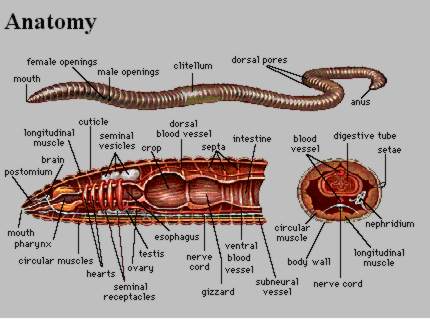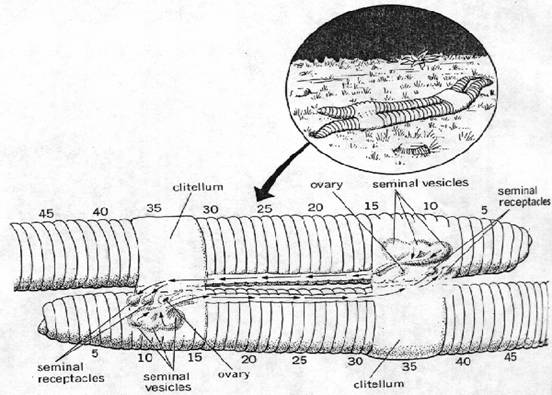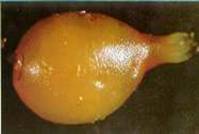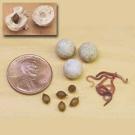Our Planet Needs Your Help... Your Own Backyard is a Good Place to Start!
Have you ever thought about the world’s land-fill problems? Have you wondered what will happen when the landfill fills up, or are you concerned about the pollution our garbage creates?
"I am the vine, you are the branches. He who abides in Me, and I in him, bears much fruit; for without Me you can do nothing.” - John 15:5
The Worm
The Basic Earthworm
Earthworms are mother-nature's clean-up crew. They have been on earth for hundreds of thousands of years longer than mankind, largely untouched by evolution due to their nearly perfect adaptation to nature.
Mankind has studied and learned to appreciate the earthworm. We use the earthworms in reducing organic “waste” materials, taking the pressure off on landfills and aiding in the regeneration of our valuable top soils.
When looking at worm organic management systems, it is important to be clear on the intended goal of the project. Worm systems are typically managed for one of three reasons; waste management, production of worm biomass (reproduction) and the production of worm castings. While worms are being grown, organic materials are being processed, and castings are being generated in all worm beds, management methods will vary to some degree depending on the focus of the system.
Vermicomposting is the practice of using worms to convert organic materials into usable vermicompost (worm poop/worm castings). This type of organic management system focuses on the waste material and managing it, so that it can be successful and efficient when using a worm organic system.
Castings production systems are worm-processing beds that use feed-stocks (manure, organic waste, etc.) specially blended so that castings have a specific nutrient value, chemical characteristic or cross section of microorganisms. The focus of these systems is on end product value.
Vermiculture systems focus on producing the maximum output of worm population possible in a given space.

Worms are basically a very efficient digestive tube. Food (your organic waste) goes in one end and comes out the other as plant food (castings/poop). They have no eyes, ears or nose but a rather large, toothless mouth which inverts itself over a piece of food, then retracts to push the food directly into the digestive system. This food is processed by a secretion of calcium carbonate, millions of bacteria and other micro-organisms and also ground by grit from soil the worm ingests resulting as nutrient and life-rich castings excreted from the anus. In an average adult worm, digestion takes about twenty-four hours. Ideally, food needs to be partially pre-composted for worms to eat which is achieved naturally in a worm compost system by a combination of aerobic and anaerobic bacteria and other associated organisms.
A worm's body is segmented. Surrounding a long muscle along the length of the digestive tube, each segment is a circular tube of muscle filled with water. This water can be pushed from one segment to another creating hydraulic motion. The water will be pushed to the back end of the worm (posterior) while the front (anterior) stretches forward. The front will then fill with water while the back retracts to catch up and so on. A worm can be short and fat one moment and long and thin the next. Similarly, when moisture is plentiful, the worm will absorb more and be larger than when conditions dry out.
Spaced around each of the segments are setae. These are short bristly hairs with several functions. They are extremely sensitive to light and movement, warning the worm that it has surfaced or is in danger and they are also used for grip. When navigating a vertical burrow, the setae are used to grip the walls so the worm doesn't fall and they also help the worm to move along the ground. When a worm feeds on the surface, its anterior will be firmly gripping the burrow for a quick retreat if necessary.
The segments are covered by skin and interrupted only by the clitellum ring which is always closest to the mouth end of the worm. A developed clitellum denotes sexual maturity, which in compost worms will be at about two to three months.
Worms are hermaphrodites, that is, they are both male and female in one. They can self-fertilize but they usually mate in pairs. During mating, two worms come together and overlap from the front to the clitellum. A thick gel is secreted around both worms and sperm is ejected under the gel to be stored in the sperm duct of each worm which each then goes its separate way. Immediately, a mucous ring forms over the clitellum which the worm begins to wriggle backwards out of and in doing so, ovum is collected from the ovary ducts and sperm from the sperm ducts thus resulting in fertilization within the ring. The ring then closes into a capsule as it slips off over the head of the worm. Each capsule will contain multiple babies and many capsules can be produced from the one mating.
Because they need the right temperature for mating, breeding can drop off during extreme weather conditions but in a large system this is less of a problem. Adding extra food during winter will provide more warmth for worms and less food in summer will keep the system cooler.
Worms have the ability to sustain the optimum population according to the available food and space. While conditions are right, they will breed at full potential until the desired food and space ratio is reached. This is an excellent scenario in a compost situation as the more food you add, the more they populate.
A worm's circulatory system is controlled by several simple hearts pumping blood to a ventral vessel, a dorsal vessel and capillaries. They have a very sensitive nervous system of which the setae are major sensors and a tiny, insignificant brain.
Although their anatomy is very simple, worms are one of the strongest animals on Mother Earth for their size and have been around for millions of years!
Oxygen Requirements
Worms are oxygen-breathing animals that absorb oxygen directly through their skin. Oxygen is dissolved into outer coating the worm's skin and the dissolved oxygen passes through the skin and the walls of capillaries lacing the skin where it is picked up by hemoglobin in the worms blood and carried throughout the body.
Moisture Requirements
Moisture is critical to the survival of all worm species because it is moisture within the worm's body that gives it, it shape, enables it to move, and aids in the worm's ability to absorb oxygen. The skin of the worm is very thin and permeable, meaning that the moisture within the body cavity is easily evaporated off, particularly in dry environments. The moisture range for most worm species is from 60-85%, which ensures the worm can absorb as much moisture as may be lost.
Temperature Requirements
Specific temperature requirements and tolerances vary from species to species, though the ideal range for most composting worms is between roughly 55-77° F. The worm's ability to tolerate temperatures outside this depends on the level of moisture and oxygen in the system.
Food Requirements
Earthworms rely on microorganisms to begin the breakdown of organic matter so it can be ingested, then relying on naturally occurring bacteria and fungi in their gut to digest their food. In the process of taking in this biologically active predigested organic matter the earthworm also ingests small particles of sand and soil, which lodge in their gizzard. As the organic matter and microbial life move through the gizzard, they are ground against the gritty particles lodged there and fragmented into smaller pieces, making them easier for the gut organisms to digest.
Studies show that it is not from the organic matter itself, but from the bodies of the microbial life rotting the organic matter that epigeic earthworms derive the bulk of their most vital nutrients. Once thought to be debris feeders, we now understand that the earthworm is actually a predator of microbial life, relying on microscopic bacteria, fungi, protozoa and algae as their major sources of nutrition. Anything that will support microbial activity, that is, anything that rots, is potentially suitable food for earthworms. Materials that support the greatest level of earthworm activity are those that support the greatest and most diverse populations of microbial life.
pH Requirements
As microorganisms break down organic matter it goes through a series of naturally occurring changes in pH. Because earthworms thrive in environments rich in decaying organic matter they adjust to pH fluctuations with little or no change in their activity levels. In nature, worms are found in environments with a pH range from 4-9, with processing and reproductive rates being no different at an acidic 4 than they are at an alkaline 9. With a pH tolerance this wide it is unusual for pH to be a limiting factor in any worm organic management system. If the system is suddenly and radically altered it forces many of these organisms into dormancy and sometimes kills them outright, thus reducing the availability of nutrition to the worms and potentially slowing the processing rate of the organic matter to decompose.
The addition of lime to any worm system is generally discouraged except in those extremely rare circumstances where the pH has dropped well below the worms' level of tolerance.
Reproduction
Earthworms are hermaphrodites, meaning each worm possesses both male and female reproductive organs within one body. Most earthworm species require that two worms exchange sperm in order to produce their young.
When worms mate they lay side by side with their heads pointed in opposite directions, making close contact along the upper segments of their bodies. They excrete a mucous that coats both worms and binds them together, preventing them from being easily pulled apart and ensuring no interference with the exchange of sperm.
The worms exchange sperm, storing the received seed in a pore on the skin surface just above the clitellum (the differently colored or thickened band that encircles the worm body). Once they exchange sperm, a process that may take hours, the worms move apart and eject their own ova into a pore on their skin surface near the sperm pore. They secrete a thick mucous around the clitellum, which hardens on the outside but remains sticky underneath, forming a band out of which the worm backs, drawing the band over its head. As the band passes over the pores holding sperm and ova they are picked up and held on the sticky underside. Once the worm has backed completely out of the hardened mucous the ends close forming a cocoon with sperm and ova inside where fertilization takes place. Each worm will continue to produce cocoons until they have used all of the sperm received from their mate.
 |
|
 |
 |
The length of time it takes for the baby worms inside the cocoon to mature and “hatch” out, and the number of young in each cocoon depends on the worm species and environmental conditions.
The worm cocoon is an incredibly tough structure, designed to protect the young inside from environmental extremes and even ingestion by other animals. Cocoons can be frozen, submerged in water for extended periods of time, dried and exposed to temperatures far in excess of what can be tolerated by adult worms without damage to the young worms inside. In areas of climatic extremes it's likely that the adult members of epigeic worm species do not survive, but the cocoons do, repopulating the environment when environmental conditions return to a range that can s support worm activity.
Earthworm cocoons are easy to spot in the worm bed. They are roughly the size of a large grape seed and similarly shaped, with one end rounded and the other drawn out to a point. When first dropped from the body of the parent the cocoon is a creamy, pearlescent yellow, darkening to a cola brown as the young worms within mature and prepare to emerge.
